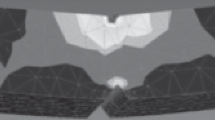Abstract
Grain-boundary segregation of impurity elements, such as phosphorus, arsenic, antimony, and others, decreases the grain-boundary cohesion, which can substantially increase the temperature of the ductile-brittle transition in low-alloy structural steel. The most dangerous surface-active impurity for low-alloy steel employed for nuclear reactor vessels is phosphorus. A change of the cohesive strength of grain boundaries as a result of radiation-stimulated phosphorus segregation is considered to be one of the main mechanisms determining the radiation embrittlement of reactor-vessel materials. Since the mechanisms of embrittlement during development of reversible temper brittleness and radiation-stimulated grain-boundary segregation of phosphorus are the same, the main characteristics of the influence of the latter on the mechanical properties of steel can be determined by investigating steel treated in the range 400–600°C. The present investigation made it possible to develop a relation for determining the change in the temperature of the ductile-brittle transition in low-alloy steel as a result of the development of temper brittleness.
Similar content being viewed by others
REFERENCES
A. V. Nikolaeva, Yu. A. Nikolaev, and A. M. Kryukov, “Grain boundary embrittlement due to reactor pressure vessel annealing,” J. Nucl. Materials, 211, 236-243 (1994).
Yu. A. Nikolaev and A. V. Nikolaeva, “Embrittlement of low-alloyed steels dur to impurity segregation at intergranular boundaries,” Materials Sci. Forum, 207-209, 653-6656 (1996).
Yu. A. Nikolaev, A. V. Nikolaeva, O. O. Zabusov, et al., “Radiation and heat induced adsorption of phosphorus on grain boundaries in low-alloy steel,” Fiz. Met. Materialloved., 81, 120-128 (1996).
L. M. Utevskii, E. É. Glikman, and G. S. Kark, Reversible Temper Brittleness of Steel and Iron Alloys [in Russian], Metallurgiya, Moscow (1987).
P. L. Gruzin and V. V. Mural', “Mechanism of the effect of molybdenum on reversible temper brittleness of steel,” Metalloved. Termoobrab. Metal., No. 3, 70-72 (1969).
P. L. Gruzin and V. V. Mural', “Effect of doping on phosphorus diffusion in ferrite,” Fiz. Met. Materialloved., 17, 384-389 (1964).
O. A. Kaibushev and R. Z. Valiev, Grain Boundaries and the Properties of Metals [in Russian], Metallurgiya, Moscow (1987).
V. Vitek, D. Smith, and R. Pond, “Structure of boundaries in b.c.c. metals,” Phil. Mag. A, 41, No. 5, 649-663 (1980).
M. Hashimoto, Y. Ishida, R. Yamamoto, and M. Doyama, “Atomic studies of grain boundary segregation in Fe-P and Fe-B alloy,” Acta Met., 32, No. 1, 1-11 (1984).
M. Hashimoto, Y. Ishida, R. Yamamoto, et al., “Transformation of the grain boundary structure in iron by phosphorus segregation,” Scripta Metallurgica, 16, No. 3, 267-270 (1982).
M. K. Miller, R. Jayaram, and K. F. Russell, “Characterization of phosphorus segregation in neutron-irradiated Russian pressure vessel steel weld,” J. Nucl. Mater., 225, 215-224 (1995).
D. MacLean, Grain Boundaries in Metals [Russian translation], Metallurgizdat, Moscow (1960).
P. Bischker and R. Wild, “A microstructural study of phosphorus segregation and intergranular fracture in neutron irradiated submerged-arc welds,” in: Effects of Radiation on the Materials. ASTM STP 1270 (1996), pp. 260-273.
I. Langmuir, J. Amer. Chem. Soc., 40, 136 (1918).
B. S. Bokshtein and L. S. Shvindlerman, “Effect of internal adsorption in solids,” Preprint IFTT AN SSSR, Chernogolovka (1978).
E. Hondros and M. Sesh, “Segregation to interfaces,” Intern. Met. Rev., No. 12, 261-303 (1977).
M. Seah and E. Hondros, “Grain boundary segregation,” Proc. Roy. Soc. Lond., 503A, No. 1601, 191-212 (1973).
R. Fowler and E. Guggenheim, Statistical Thermodynamics, Interscience Publishers, Cambridge (1960).
A. Ucisik, C. McMahon, and H. Feng, “The influence of intercritical heat treatment on the temper embrittlement of rotor steels,” Met. Trans., 9A, No. 3, 321-329 (1978).
G. Spink, “Reversible temper embrittlement of rotor steels,” ibid., 8A, No. 1, 135-143 (1977).
M. Guttmann, “The role of residuals and alloying elements in temper embrittlement,” Phil. Trans. Roy. Soc. Lond. A, 295, 169-196 (1980).
M. Seah, “Grain boundary segregation and the T-t dependence of temper brittleness,” Acta Met., 25, No. 3, 345-357 (1977).
G. S. Kark, “Effect of phosphorus concentration in perlite steel on grain-boundary impurity maximum of internal friction,” Trudy TSNIITmasha, No. 178, 23-34 (1983).
M. Guttmann, “The link between equilibrium segregation and precipitation in ternary solutions exhibiting temper embrittlement,” Metal Sci., No. 10, 337-341 (1976).
A. V. Nikolaeva, Yu. A. Nikolaev, and A. M. Kryukov, “The contribution of grain boundary effects to low-alloy steel irradiation embrittlement,” J. Nucl. Mater., 218, 85-93 (1994).
Standards for Calculating the Strength of Equipment and Pipes in Nuclear Power Plants PNAÉ G-7-002-86 [in Russian], Énergoatomizdat, Moscow (1989).
G. S. Kark and A. A. Astaf'ev, “Temper brittleness of low-alloy Cr-Ni-Mo steels,” Trudy TSNIITmasha, No. 177, 43-66 (1983).
A. V. Nikolaeva, Yu. A. Nikolaev, D. M. Shur, and A. A. Chernobaeva, “Prediction of the tendency of Cr-Ni-Mo steel to temper brittleness,” Fiz. Met. Materialoved., 76, 163-170 (1993).
A. V. Nikolaeva, Yu. A. Nikolaev, and A. M. Kryukov, “Estimation of grain boundary embrittlement due to reactor pressure vessel annealing,” Preprint NSI-3-93, Nuclear Safety Institute, Moscow, Russia (1993).
S. Takayama, T. Ogura, Shin-Cheng Fu, and C. McMahon, “The calculation of transition temperature changes in steels due to temper embrittlement,” Met. Trans., 11A, No. 9, 1513-1530 (1980).
A. Polit, R. D'Anna, and J. Buzzichelli, “Effect of austenite grain size and thermal history on low-temperature of Ni-Cr-Mo-V rotor steel,” Met. Sci., 15, No. 6, 278-280 (1981).
N. P. Mel'nikov, L. I. Gladshein, L. G. Gavrilenko, et al., “Steel with carbonitride hardening of electroslag remelt for large pressure vessels,” Stal', No. 12, 65-69 (1985).
C. McMahon, D. Gentner, and A. Ucisik, “Investigation of effect of grain size and hardness on the threshold of cold-brittleness of steel 2.25 Cr-1Mo, subjected to temper embrittlement,” Teor. Osnovy, 106, No. 1, 66-70 (1984).
Author information
Authors and Affiliations
Rights and permissions
About this article
Cite this article
Nikolaeva, A.V., Nikolaev, Y.A. & Kevorkyan, Y.R. Grain-Boundary Segregation of Phosphorus in Low-Alloy Steel. Atomic Energy 91, 534–542 (2001). https://doi.org/10.1023/A:1012482419952
Issue Date:
DOI: https://doi.org/10.1023/A:1012482419952



